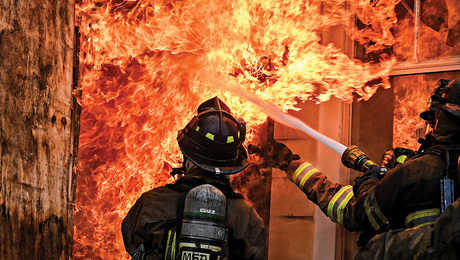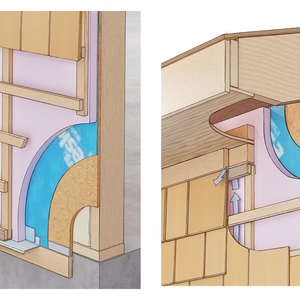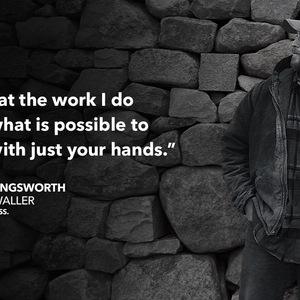has any one worked with flagstone that comes attached to plastic matting in a modular pattern? the pattern is sort of like stamped concrete.
my partner/boss and i have to mortar down a few pallets of this stuff, and it seems both straightforward and kind of weird. anybody got advice?
k



















Replies
bumping my own q here.
my biggest concern is how tricky it will be to get the height of the stones close as they are glued to this matting.
i would ordinarily just pull a stone out and add some more mortar or back-butter it if it needed a bit more height, but since they're attached to matting, that won't work.
has anyone ever seen this stuff? It's quartzite flagstone arranged in a repeatable pattern on a plastic mesh backing. (the client picked it after our local stoneyard ran out of the loose stone in the color she wanted.)
k
I just saw this on tv and I thought it would be hard to handle all those attached pieces. I think they are attached pieces in a repeating pattern and may give misleading impression that they are faster to install. I have no experience with this type of tile but here are what I heard and saw:
First make sure the slab surface is even so that you can lay the bedding with notched trowel for even layer and you don't have to adjust the tiles too much after laying them down. Make the bedding stiff so there is a little chance of middle piece settling and brush on concrete bonder or soupy mix of thinset on the back of the pieces. I don't know what the bonding strength would be with stiff mix and brush on back-buttering. Maybe you can back butter with thinner trowel mix and handle the pieces with a helper.
I assume all those pieces have about the same thickness. Looks like it could be messy work, so you may have to seal them before the installation. If this doesn't work, and if you are stuck with using these stones, may be cut a template of the pattern, mark the pattern on fresh bedding and cut the matting and lay the pieces like the individual pieces within the mark you made. Hope this helps and good luck.
Thanks. Your description sounds like this stuff. what show was that?
You are onto something about the slab being even- we already poured the base slabs for the walkways and outlying patio, but a large area is going onto an existing and very uneven slab. that looks like trouble.
we'll probably lay backer board first to try to even things out, more work obviously. I think if anything, this stuff will be more time-consuming than loose stone. The client has strong opinions about color, tho, and this stuff was the best match available. oh well.
k
what exactly is a "partner/boss"?
sounds like all the responsibility with the paycheck of a lackey
"what exactly is a partner/boss"
It's not as bad as it sounds. We both have GC lic's, sometimes I bill the client, sometimes he does, sometimes we both do. On this job I'm technically his employee, so he bills, and (more importantly) explains why it's taking so freaking long to lay these weird stone mats.
I never know how to classify my clients either, most of them become friends, so when they're at my bbq's I'm always like "this is my client, er friend, and this is my friend, er boss, etc..." It's a nice kind of confusion, though.
And, yes, when I've legally been his employee, he has paid worker's comp and taxes as such.
k
ps any advice on the modular flagstone mats?
This does sound like a pain.
How big are the mats?
If it is a repeating pattern how wide are the joints?
the mats are about 40" long, and about 24" wide at the middle. they're kind of shaped like a elongated cross. The stones are stuck to plastic mesh with globs of epoxy.
they are repeating and interlocking as units, and symmetrical so you can spin 'em 180. they remind me of concrete stamps, but the stone is real. gaps vary, but are approx. 1/2".
we took one pallet to play with (the rest comes friday) and found that while every mat has the same shape outline, there are three different versions as far as the way the stones are layed out in the mats.
each version has six or seven stones exactly like the stones in the other mats of the same version, if that makes sense. (I apologize for not having photos).
We called one version "seven", because it had seven stones, one version "butt-crack" because two of the stones in it reminded me of a butt, and the other one "six-pack" b/c it had six stones but no butt crack. So each "butt-crack" mat had a pair of stones that looked like a butt, and was just like the others.
We even started id'ing individual stones so we could fill in partial areas- "We need a Nevada for that corner, and an Iceberg for the other side..." because you could look at a whole mat and tell which part of the pattern would fit the leftover space.
We only got this stuff b/c the color of loose stone the client wanted was gone, and this was the best match color-wise. She specifically chose it at the yard over other colors of loose quartzite flag.
If we had been sold on it as a fast method, I'd be mad. I guess if you had a single large area and didn't care too much about some uneveness, it might make sense. In this case, it's a t&m job, and she knew it might be challenging, so no real problem. I won't be recommending it, tho.
k
So this is a man-made product......a concrete faux flagstone ?Does it have a name....website.....
It is (I'm almost certain) natural stone(s). The face sides are a split surface, and you can see the saw marks on the back side. I guess they cut scrap stones to make the 20 or so individual shapes, then lay them out to some template.
I don't know the name. I wasn't there when the client picked it out, and the guys at the yard are professing ignorance about this stuff. (a lot of complaints?)
k1c said he saw it on a tv show, if he tells me what show, I'll try to find the episode, then more details. or maybe I should just google it...
k
ok, i googled it. http://www.realstonesystems.com, and a couple others. natural stone. I'm still not very into it.
k
(edited: corrected web address. sorry.)
Edited 5/21/2008 10:25 pm ET by KFC
Yeah seams like a failed attempt to make stone high tech.
I guess it could work ok, but I have two problems with it.
one: the mats are composed of smaller stones with a lot of joints to grout. at the same yard we got this stuff, they have plenty of quartzite flags bigger than the mats themselves. sure, you'd have to cut to fit, but we've got a saw. That seems like less work, frankly. Definitely way less grouting.
two: The stones aren't all the same thickness; which I'm used to, but if you want to add mortar and re-set some of the stones, you have to cut the matting to pull the low stone, disturbing all the stones in the mat and getting mortar everywhere. If we're cutting the matting up, doesn't that defeat the purpose?
I guess most guys wouldn't worry about the 1/8th inch here or there, but the client is just about blind, so we're trying to get it as flat as possible. (And yes, I did suggest that flagstone might not be ideal for a legally blind client...)
k
Oh I completely agree. I'd much rather just lay stone.
Just trying to figure the best way to deal with the stuff. Seams like every time the issue of irregular gauge comes up
you end up, trying to fatten the bed joint to compensate. Bad idea, I've had some pop that way. Also you're pounding on stones
til the cows come home. Maybe you need to more clearly explain it to the client.
I've never had a callback for poppage, but I guess it is a risk, if you use too much mortar. I usually add either extra portland or lime, or bonding agent if I'm worried about stickiness. Or are you talking about the mortar itself failing?
On the other hand, if you don't allow for the thickest stone (and build up the thinner ones), what are your options? grinding stone or slab seems crazy.
I guess you're saying don't worry about minor differences, it is stone, after all. I tend to agree. I expect in this case though, the client will rather pay for the extra time to struggle for near perfection, and fix pops if they happen as part of that ongoing struggle.
She's been good over the years about understanding the cost/quality relationship. Sometimes the struggle for perfection is fun, sometimes pointless. But she has never busted my b*lls over price, at least.
k
ps I know you weren't saying this stuff seemed like a good idea. that's why I vented my specific gripes to you- I knew you'd agree about the drawbacks. I actually feel better just for specifically posting my gripes, now I can let 'em go. thanks.
What are you guys paying for flagstone in your area?
Depends. Here in the east bay Arizona sandstone flag goes $250-300/ton or $350-400/ton (bulk vs. hand select), the quartzite stuff runs $425-600/ton. Then there's your slates and bluestones and whatnot, anywhere from $450-800/ton. I'm envious of the easterners and their bluestone...
sq. footage varies depending on thickness, but approx. 100sf per ton for 1-1.5" stone.
I don't actually know what the client paid for these flag mats I'm grumbling about.
k
Interesting, sounds like laying cultured stone only like tile.
So you tuck point the joints at the end?
I'll bet laying it won't be that bad. It'll be the #### around at the end that will have ya cursing.
One of these might save you some time on your knees. Mix the mud a little wetter then normal, let it set up, then point it as usual.
Halves my pointing time.http://www.albioneng.com/products/Product.asp?ID=38PS
It is prone to jamming, nothing to be done about it. Just open it up
and clean out the jam and keep going.
Sorry, not on a show, just a commercial. Using bonder or slurry, I once did a slate walkway and I think that's when I was advised about this from the installer at the tile store. Come to think of it, about the even slab and using the thinset as well. I ended up just using mortar and back buttering to even out the tiles. I used existing rough surface slab.
If this mat tile must be used, best action seems to be to even out the uneven slab, matching to the even part, with mortar screed. When ready, use thinset to lay the tiles. I was told that there are thinsets made for outdoor use to allow for freeze-thaw cycles. Indoor baths are done this way without back buttering the tiles sheets so I don't see why outdoor tiles can't be done this way. Just using water to wet the tiles may be enough with thinset. Hope this helps and good luck.